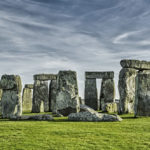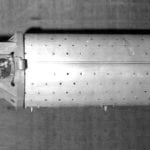 Mysteries
Mysteries  Mysteries
Mysteries  History
History 10 Surprising Stories About the Texas Rangers
 Humans
Humans 10 Philosophers Who Were Driven Mad by Their Own Theories
 Miscellaneous
Miscellaneous 10 Video-Game-Worthy Weapons and Armors from History
 Weird Stuff
Weird Stuff 10 Psychics Who Accurately Predicted Wartime Events
 The Arts
The Arts 10 Pieces of Art Inspired by a Broken Heart
 Health
Health 10 Science Fiction-Sounding New Medical Treatments
 History
History 10 Surprising Facts About the Father of Submarine Warfare
 Space
Space Ten Astonishing New Insights into Alien Worlds
 Weird Stuff
Weird Stuff 10 Bizarre Summer Solstice Rituals Still Practiced Today
 Mysteries
Mysteries Top 10 Haunting Facts About the Ghost Ship MV Alta
 History
History 10 Surprising Stories About the Texas Rangers
 Humans
Humans 10 Philosophers Who Were Driven Mad by Their Own Theories
Who's Behind Listverse?

Jamie Frater
Head Editor
Jamie founded Listverse due to an insatiable desire to share fascinating, obscure, and bizarre facts. He has been a guest speaker on numerous national radio and television stations and is a five time published author.
More About Us Miscellaneous
Miscellaneous 10 Video-Game-Worthy Weapons and Armors from History
 Weird Stuff
Weird Stuff 10 Psychics Who Accurately Predicted Wartime Events
 The Arts
The Arts 10 Pieces of Art Inspired by a Broken Heart
 Health
Health 10 Science Fiction-Sounding New Medical Treatments
 History
History 10 Surprising Facts About the Father of Submarine Warfare
 Space
Space Ten Astonishing New Insights into Alien Worlds
 Weird Stuff
Weird Stuff 10 Bizarre Summer Solstice Rituals Still Practiced Today
Top 10 Most Amazing Facts About Saturn and Its Rings
Known by some as the “ringed planet,” Saturn is famous worldwide for its stunning ring system and is the most recognizable planet in the solar system. As for the rings, they do a rather quirky thing: They perform a “disappearing act” every 14 to 15 years. It was the great Galileo who first observed the missing ring system of Saturn that he scientifically described as looking like “ears.” This phenomenon must have had many an astronomer pulling their hair out. The reason why they disappear is kind of like an optical illusion, but not.
What actually happens is that every 14 to 15 years, Saturn rotates so its rings get fixed in an edge-on direction directly toward us, causing them to only seem to disappear from sight. However, obviously, they’re still there and didn’t go anywhere; they simply become invisible to us. And the reason is clear and simple: The thickest ring in the system is only 98 feet (30 meters) thick, and we’re 887 million miles (1.4 billion kilometers) away. They’re just too astronomically thin for us to see from Earth, so they become invisible. Saturn also just happens to be an excellent performer, by the way.
Please read on to learn more astounding facts about this majestic gaseous giant.
Related: Top 10 Giant Facts About the Dwarf Planets
10 How and Why the Romans Named Saturn, Saturn
The ancient Romans could plainly observe the seven dominant celestial lights of the night sky: the Moon, the Sun, and the five most luminous planets. And they named them in honor of their gods. According to Roman myth, Saturn taught his charges agriculture by teaching them how to farm their land. Saturn also ruled time, is the father of Jupiter, and is the namesake for Saturday, or to the ancient Romans, Saturn’s Day.
The Romans revered Saturn so much that they held a huge annual festival in its name that they dubbed Saturnalia. During this extravagant affair, some things normally frowned upon—and even forbidden—were tolerated. For instance, gambling was completely outlawed, but one could gamble during Saturnalia, but only with nuts to bet with. They didn’t allow money to be used as a precaution to ensure the return to the Golden Age of Saturn. Obviously, they didn’t wish to anger the gods. Don’t you just love the Romans and all their reasons to party?[1]
9 You Couldn’t Stand on Saturn Even if You Wanted To
Saturn is not just a ball of churning liquids and gases. In fact, it is made up entirely of them, which is why there’s no solid surface to land or stand on. Ironically, a spacecraft would have no problem with the atmosphere, which is made up almost exclusively of hydrogen and helium: 75% and 25%, respectively, with trace amounts of substances like ammonia and methane.
You can’t stand on the rings either, even though they look solid from millions of miles away here on Earth because they’re made up of billions, maybe trillions of particles of ice and rock, ranging in wildly varying sizes, from a grain of sand to a skyscraper. Another truly astonishing fact is that planet Earth outweighs Saturn’s entire ring system by an astronomically unbelievable 200,000 times!
Even though there’s nothing to stand on, Saturn does have a rocky core, but its surface gets hotter than the sun’s at 15,000°F (8,315°C), while the sun’s surface is “only” 10,000°F (5,537°C). The gas giant’s core gets up to a rather toasty temperature, so even though there is rock on Saturn, walking on it would be a very unpleasant stroll in the park.[2]
8 How Old Are Saturn’s Rings
Contrary to popular belief, Saturn’s rings aren’t thought of by scientists to be 4.5 billion years old any longer. Recent studies using data sent back by the Cassini mission have many planetary scientists scratching their heads while at the same time accepting the theory that Saturn’s ring system is young: only one hundred million years young. This is, in fact, a far cry from the 4.5 billion years of the ousted one. The kicker was quite simple: The material that the rings consist of is too clean and dirt free. Simply put, after so many billions of years, the rings would’ve gotten so dirty, we would’ve never been able to detect them from here on Earth.
The latest theory on the formation of the rings involves the existence of a long-missing moon. After having its orbital path disrupted by Titan, it was forced in too close to the gas giant by Titan’s gravitational influence and additional tidal forces supplied by Saturn. This then tore the unfortunate satellite asunder into billions of particles. It is these particles that scientists postulate are what formed Saturn’s stunning and iconic ring system that we’re all so familiar with—but only one hundred million years ago, not 4.5 billion.
FYI: Saturn can be seen with the naked eye after the sun sets at night. Under magnification, it has a murky yellowish-brown look to it. The rings can be seen with just a 25x to 40x telescope. In fact, most sighting scopes mounted on telescopes would suffice to view the rings of Saturn.[3]
7 One Year on Saturn Is 30 Earth Years Long
As I’m sure you’re aware, a year on any planet anywhere is recorded by a completed orbit around its host star. For Saturn, one orbit of the sun takes 29.4 Earth years. How would you like to live to be 70 on Saturn? You’d only be 2,058 Earth years old by then, but hey, who’s counting, right?
There are several theories of why Saturn takes so long to complete an orbit around the sun. First, some point out that Saturn is 10 times further from the home star than Earth is, and it travels through space at a much slower pace. They believe that’s the reason: It’s simply moving slower through space and has a very long way to go to complete an orbit.
Others postulate that the rings cause a strong magnetic field that exerts a bipolar-type force affecting the planet, like a car when the driver is riding the brakes, by causing drag similar to what aircraft experience here. As stated, there’s the astronomical distance Saturn has to travel to orbit around the sun: 1.4 billion miles. Now that’s one long road trip.[4]
6 Saturn Is Really, Really Big
Saturn is simply ginormous. So much so it would take over 700 planet Earths to fill the gas giant. Of course, it is second in size only to Jupiter, the largest planet in our solar system. Saturn has a diameter of 72,364 miles (116,460 kilometers), compared to Jupiter’s at 86,880 miles (139,820 kilometers). For comparison, it would take over 800 Earths to fill Jupiter.
Saturn’s rings are theorized to be a collection of debris from celestial collisions that the gas giant’s intense gravitational pull has drawn into its orbit. They’re made up of billions, maybe trillions of particles ranging in size from grains of sand to skyscrapers, with a few the size of mountains. They’re formed from particles and pieces of rock and ice coated with a fine dust. If one could stand on top of Saturn’s clouds, the rings would look snowy white, with different rings rotating in opposite directions. Now that would be some sight to see.[5]
5 Saturn Is a Ginormous Solar Radio
The Cassini spacecraft was equipped to monitor high-energy radio emissions coming from Saturn. These emissions are related to the auroras emitted from both poles of the majestic planet and are very similar to the Southern and Northern lights here on Earth. In April 2002, the Cassini spacecraft first detected radio emissions with its Radio and Plasma Wave Instrument, designed to detect and record Saturn’s radio emissions. It was so sensitive and powerful that it started picking up radio emissions from Saturn from an astonishing distance of 234 million miles (374 million kilometers) from the gas giant. We sure got our money out of that one!
Cassini was lifted into orbit by a Titan IVB-Centaur rocket from Cape Canaveral Air Force Station in Florida on October 15, 1997. This highly-sensitive instrument displays an astonishing array of fluctuations in radio frequencies. Saturn’s complicated radio spectrum, with its rising and falling tones and wide range of frequencies, is not much different from the auroral radio emissions here on Earth at both poles. These results tell us that are many small radio sources traveling along magnetic field lines weaving through the auroral region of Saturn.
Cassini performed flawlessly for almost 20 years until she was intentionally sent into Saturn’s atmosphere in a controlled descent by NASA on September 15, 2017. Cassini was an outstanding spacecraft. To say it greatly enhanced our knowledge base on this once very enigmatic celestial behemoth would be an understatement.
Cassini was a scientific gold mine and didn’t just study Saturn in detail. She studied a good portion of the Saturnian system, including the rings, several of the giant’s moons, and more, while sending back a variable wealth of scientific data. Cassini also successfully launched the Cassini-Huygens probe and collected the expected data from the probe’s successful landing and deployment.[6]
4 Saturn’s Moon Enceladus Works Like a Giant Can of Spray Paint
Being the sixth-largest moon of Saturn, Enceladus is ranked 19th in the solar system in size: 310 miles (500 kilometers) in diameter. For comparison, it is a tenth the size of Titan, the planet’s biggest moon. Enceladus has the distinction of being the most reflective and brightest object in the solar system due to constantly being showered with snow and ice. This is due to a geological resurfacing process caused by Saturn’s gravitational pull, theorized to be generated by the tidal “bending” caused by the force.
This tidal action creates heat, causing geysers to frequently refresh much of the surface with more sterile ice and snow. As a result, the surface temperature at noon climbs to just −324.4°F (−198°C or 75.1K), which is much colder than a light-absorbing object should get. Despite this, its diminutive stature has an extended variety of surface features that range from ancient, heavily-cratered areas to regions of terrain that are younger yet tectonically contorted.
When discovered in 1789 by William Herschel, very little was learned about Enceladus for almost two centuries. Then Voyagers 1 and 2 performed flybys of Saturn in 1980 and 1981, but only Voyager 2 got photographs, while Voyager 1 had technical difficulties with its camera during its flyby. In 2005, Cassini performed several flybys of the moon, even flying through a plume and gathering data on it, disclosing a wealth of knowledge about its surface environment in stunning detail.
One of the most intriguing discoveries was a geyser being caught on camera venting a plume of vaporized water out into space close to the south pole. There’ve been 101 geysers located on Enceladus. A portion of the water vapor they release falls back to the surface as snow, while some actually “spray paint” everything that flies over and too closely, which then promptly freezes like drying paint.[7]
3 Titan, Saturn’s Largest Moon, Is Bigger Than a Planet
Larger than the planet Mercury is Titan: Saturn’s largest moon and second largest in the solar system. It ranks behind only Ganymede, Jupiter’s largest moon, that beats Titan by only 2%. The atmosphere of Titan is mostly nitrogen, as it is here on Earth, and planetary scientists theorize that there are rivers, lakes, clouds, rain, and oceans of liquid hydrocarbons like ethane and methane on the planet.
However, when the Cassini-Huygens probe landed on the surface of the huge moon, it took photographs of a rocky and barren surface with no lakes or rivers in sight. Scientists have evidence and postulate seas of methane hundreds of miles deep and wide. They also theorize an ocean of water existing under Titan’s crust, which could sustain life. Photographs of Titan look hazy due to an atmosphere of methane that completely blocks the view of the surface, which was the main reason for landing the Cassini-Huygens probe.[8]
2 Saturn’s Amazing Ring System
The ring system stretches out some 175,000 miles (282,000 kilometers), while the main rings average just 98 feet (30 meters) in thickness. They’ve been assigned letters in the alphabetical order they were discovered in and are relatively close to one another, with the exception of a 2,920-mile (4,699-kilometer) gap called the Cassini Division, that isolates rings A and B from each other.
As stated, starting from Saturn, the main rings, designated A, B, and C, are dense and easy to see, while rings D, E, F, and G are indistinct and a bit harder to discern. The latter rings listed here were discovered more recently than the former. Out further, there are more ending with the E ring. Even further out, there’s the Phoebe ring which tails behind the moon in its orbit.[9]
1 Saturn’s North Pole Is a 6-Sided Hexagonal Monster Storm
One of Saturn’s biggest mysteries, at least in size if nothing else, is its north pole, which has a storm raging there that’s 6-sided, or hexagonal. This massive vortex is an atmospheric phenomenon that’s been both perplexing and fascinating planetary scientists since its discovery, fueling debate and controversy ever since.
It was first photographed by the Voyager missions launched in 1977, and images of the storm were stitched together to form a complete picture by David Godfrey in 1987. This storm is at least twice as big as any hurricane ever recorded on Earth. It’s 2,200 miles (3,500 kilometers) across, with wind speeds up to 300 miles (482 kilometers) per hour.
FYI: Winds on Saturn can reach a blistering 1,118 miles per hour (1,800km/h)! In contrast, the highest wind speed recorded here on Earth is just 231 miles per hour (371km/h): almost 5 times faster! So on Saturn, there’s nowhere to land or stand, and the planet rotates so fast you’d be flung out into space—that is, unless those monstrous winds get ahold of you first. Then you’d just fly around the place for eternity.[10]








